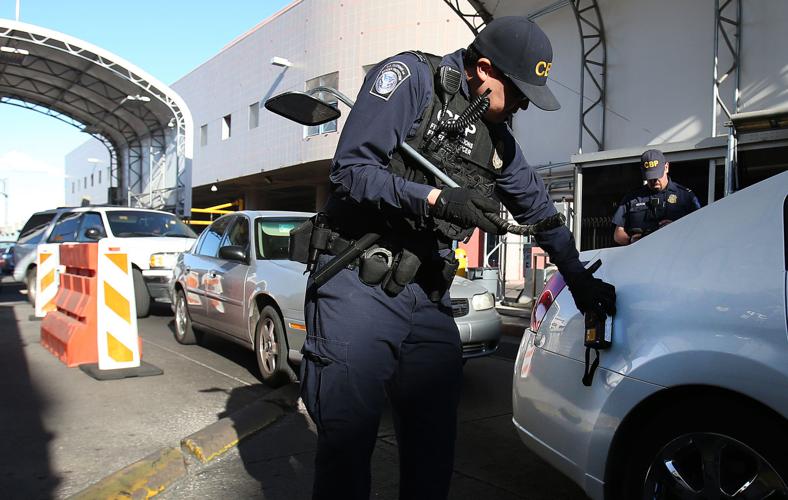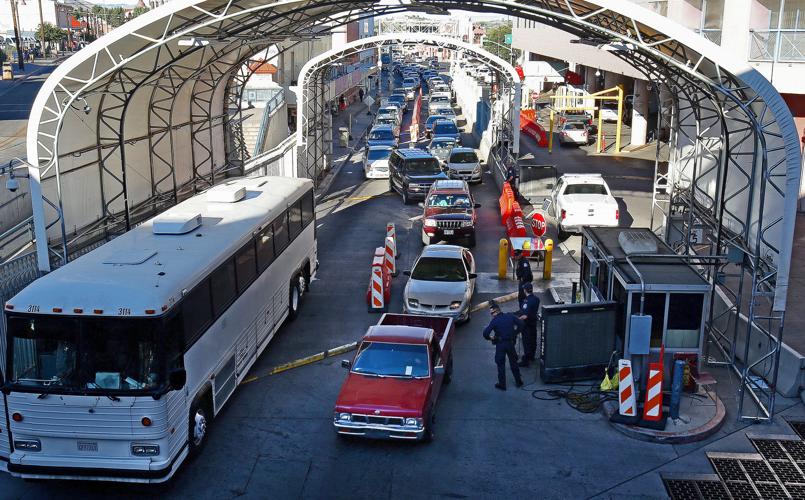When Ariana Ramirez and Andrian Alvarez tried to cross the border from Nogales into Mexico, customs officers discovered their car was loaded down with firearms and ammunition bound for a drug cartel.
Officers found two assault rifles and six high-capacity magazines under the seat where Ramirez’s two infants sat, court records show. In the center console were more than 1,500 rounds of ammunition and a $930 receipt from the United Nations Ammo Company in Glendale. Another 1,500 rounds were tucked under the Ford Explorer and a dismantled .50-caliber machine gun tripod mount was stashed in the back seat.
Ammunition-smuggling busts at Arizona ports of entry — like this one — jumped 600 percent over the past two years, U.S. Customs and Border Protection statistics show. A total of 54,000 rounds and 25 firearms were seized at the state’s ports in fiscal year 2016, statistics obtained by the Arizona Daily Star through a public records request show.
But that’s a small fraction of what’s actually getting across the border.
“It’s just scratching the surface,” said Jose Wall, a retired Alcohol, Tobacco, Firearms and Explosives agent who worked on arms trafficking into Mexico from 2000 to 2013.
Few smuggled weapons are seized
Thousands of cars cross the border every day, and it’s impossible for agents to tell which ones have guns and ammo, Wall said.
CBP seized 297 firearms and 282,000 rounds at Arizona ports of entry since 2005, while 1,135 guns and 764,000 rounds of ammunition were seized borderwide.
Many more guns than that slipped through the border during that time.
Police at crime scenes in Mexico recovered 120,000 firearms that originated in the United States, annual reports from the ATF’s International Firearms Tracing System show. Firearms from the United States accounted for 70 percent of the 173,000 illegal guns recovered by the Mexican federal police at crime scenes and sent to the ATF for tracing since 2007.
Authorities also found receipts showing that Alvarez purchased more than $11,000 worth of ammunition between March 1 and his March 27 arrest. He told investigators that he smuggled guns and ammunition during four previous trips across the border that month. Each load was bound for a drug cartel and typically consisted of two assault rifles and several thousand rounds of ammunition, he said.
Based off of those receipts, federal prosecutors estimated that Alvarez alone smuggled more than 36,000 rounds of ammunition and at least 10 assault rifles into Mexico that month, which is equivalent to two-thirds of the total seizures at Arizona ports in fiscal year 2016.
Alvarez claimed he was smuggling to save his brother, who was being held hostage by the cartel for stealing $1 million. Every time Alvarez crossed the border, the cartel would deduct $1,000 from his debt, he told authorities.
Alvarez was sentenced to nearly four years in federal prison after pleading guilty to a charge of smuggling goods from the United States. Ramirez pleaded guilty to the same charge but has not been sentenced yet.
“Needle in haystack”
Mark Hammond made it through U.S. customs’ southbound inspections on June 20, 2015, but apparently panicked when Mexican customs officials tried to inspect his backpack.
Rather than hand it over, Hammond dropped the pack and ran to the front of the inbound U.S. inspections line, court documents show. All the while, Mexican customs officials were yelling that Hammond had a gun.
Inside the backpack, CBP officers discovered five mini AK-47 pistols, five high-capacity magazines and a receipt showing he paid $2,600 for the guns and ammunition from J&G Sales in Prescott.
Hammond claimed he had no intention of smuggling guns into Mexico. Court records show police found a mini AK-47 in Mexico that Hammond had purchased a week before, indicating an earlier successful smuggling attempt.
He pleaded guilty to one count of exportation of firearms in connection with the backpack incident and was sentenced to more than two years in federal prison.
With thousands of people crossing the border every day, finding smuggled firearms and ammunition is almost impossible, said CBP spokeswoman Teresa Small.
Authorities are “ having to look for that needle in the haystack,” Small said.
Officers are trained to look for signs of nervousness or something amiss inside a vehicle. But from smuggling guns to smuggling fruit, nothing really distinguishes which crime is in progress, she said.
Just south of the border in Sonora, Mexican federal police recovered more than 6,700 firearms from January 2006 to March 2016, the newspaper El Imparcial reported.
In one case from February 2015, police reported finding 10,000 rounds of ammunition, nine magazines and seven assault rifles in compartments built into a truck’s side paneling on Highway 15, the federal route that leads south from Nogales.
In another case, a man was arrested in August on the highway between Sonoyta and San Luis Rio Colorado, Sonora, with 10 assault rifles and eight high-capacity magazines inside a hidden compartment in his vehicle, according to Mexican newspaper El Universal.
Most of the guns and ammunition smuggled across the border are headed to organized crime operations in Mexico like drug cartels, retired ATF agent Wall said.
Wall was a whistleblower in the ATF gun-walking scandal Operation Fast and Furious, when the agency’s Phoenix field office allowed weapons purchased in the U.S. across the border so agents could trace them to drug cartels. However, the guns disappeared and were found at crime scenes on both sides of the border — including the 2010 shooting death of Border Patrol agent Brian Terry.
The types of weapons seized at the border and the caliber and quantity of ammunition are characteristic of the weapons used by criminal networks, Wall said.
“Unless you’re doing some serious dove hunting, you’re not going to need more than 100 shotgun shells or, if you’re going deer hunting, you might take 20 rounds,” he said.
“Your large purchases of AK-47s and AR-15s are going to organized crime,” Wall said. “Any type of weapon or ammunition that has a similarity to the military, any trafficking of those are going to organized crime.”
Cross-border solutions
As was the case with Hammond’s and Alvarez’s smuggling attempts, most of the weapons recovered by Mexican police were legally purchased at gun shops and gun shows in Southwestern border states, a U.S. Government Office of Accountability report released in January found.
The high volume of weapons in Mexico is the result of gun policies in the United States, said Sarah Kinosian, an arms-trafficking policy analyst for the Washington Office on Latin America, a research and human rights advocacy organization.
“It’s, without a doubt, the lax U.S. gun laws that contribute to the high levels of gun violence down in Mexico,” Kinosian said. “It’s so easy to get a gun in the United States and move it across the border.”
However, retired ATF agent Wall said the gun laws in Mexico created the conditions for the thriving cross-border gun trafficking industry.
Mexico has strict firearm regulations. Citizens are constitutionally entitled to possess a small-caliber firearm that must be registered with the government. Most types of guns are exclusively restricted for use by the military.
Guns can kept only in a residence, and a special permit must be obtained to take it outside for activities like hunting.
The only place to legally obtain a gun in Mexico is a government-operated store in Mexico City, tucked away on a military base.
“There’s always going to be gun traffic to Mexico, always, because of just the necessity,” Wall said. “If it’s not narcos, it’s criminals who want a gun, or it’s the guy who tells his buddy, ‘Hey, can you bring me a gun because I want to go shoot rabbits, or I want a gun for protection.’”
Kinosian said a policy change in Mexico is needed, but such a change could be far off.
“I don’t get the sense that there is a really big push to do anything about the problem of trans-border trafficking,” she said.
One way to discourage smuggling is for Mexico to increase its border security, Wall said.
“It’s not going to be popular,” he said. “We all love to go to Mexico and not have to stop at the border and just get waved on through.”
Kinosian advocated for the Mexican government to crack down on gun-trafficking networks, as well as more proactive policing and detection by U.S. customs officers looking for smugglers.
As it stands right now, “if they don’t break any laws, then they won’t be pulled over,” she said.
Wall said the best way to combat the cross-border smuggling is a “see something, say something” approach.
“If you’re a guy in a gun store and you’re buying a gun, and you see someone buying 10 AK-47s, report it, the same way you report suspicious narco activity,” Wall said. “Because ultimately, if we can reduce the flow of guns, it helps the American gun owner because there’s less crime and less pressure on the politicians to do stuff.”









